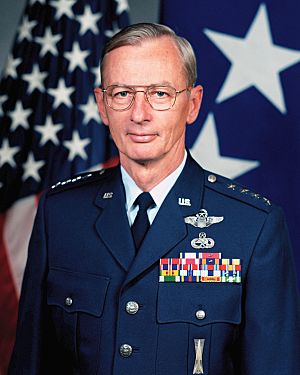Charles C. McDonald facts for kids
Quick facts for kids
Charles C. McDonald
|
|
|---|---|

General Charles C. McDonald
|
|
| Born | October 1, 1933 Barron, Wisconsin |
| Died | November 22, 2017 (aged 84) Niceville, Florida |
| Service/ |
United States Air Force |
| Years of service | 1956–1992 |
| Rank | |
| Commands held | Air Force Logistics Command |
| Battles/wars | Vietnam War |
General Charles Clarence McDonald (born October 1, 1933 – died November 22, 2017) was a very important leader in the United States Air Force. He was a four-star general who commanded the Air Force Logistics Command from 1989 to 1992. This command is like the "supply chain" for the Air Force, making sure all the planes, equipment, and parts are where they need to be.
Contents
Early Life and Education
Charles McDonald was born in 1933 in Barron, Wisconsin. He finished high school there in 1951. He then went to the University of Wisconsin and earned a degree in biology in 1956. Later, in 1966, he earned a master's degree in education from the Interamerican University of Puerto Rico in San German, Puerto Rico. He was also a top student at two important Air Force schools: Squadron Officer School and Air War College.
Becoming an Air Force Pilot
In August 1956, Charles McDonald became a second lieutenant in the Air Force through a special training program. He started his active service in June 1957 and finished his pilot training in July 1958.
From 1958 to 1961, he flew the B-47 Stratojet bomber as a co-pilot at bases in Kansas and Idaho.
Flying the B-52 Stratofortress
McDonald then chose to join the B-52 bomber program. After more training, he was sent to Grand Forks Air Force Base in North Dakota in 1962. There, he was a co-pilot, aircraft commander, and instructor pilot for the B-52H bomber. In 1965, he moved to Ramey Air Force Base in Puerto Rico, where he helped make sure all pilots met the highest standards.
Service During the Vietnam War
From 1968 to 1971, McDonald worked at the main headquarters for the Strategic Air Command in Nebraska. After that, he trained to fly the OV-10 plane. He was then sent to Da Nang Air Base in Vietnam. There, he was an operations officer for a squadron that helped guide air attacks from the ground.
After returning to the United States, he attended the Air War College. In May 1973, he went to Nakhon Phanom Royal Thai Air Force Base in Thailand. He was in charge of planning all B-52 air strikes in Southeast Asia. After the fighting stopped, he helped inspect the Vietnamese air force.
Leading Important Missions
In 1974, McDonald was assigned to the U.S. Air Force Headquarters in Washington, D.C. He helped create plans for the future of the Air Force. This included looking at how the Air Force could improve its abilities and how to use computer simulations for training. He also helped bring the airborne warning and control system (AWACS) into use for U.S. forces and NATO.
In 1978, he returned to flying duties at Ellsworth Air Force Base in South Dakota. He became a leader for the 28th Bombardment Wing, eventually becoming its vice commander.
Commander of Bombardment Wings
From 1979 to 1981, McDonald was the commander of the 320th Bombardment Wing at Mather Air Force Base in California. Under his leadership, this wing won the Fairchild Trophy. This award goes to the best bomber wing in the Strategic Air Command for excellent bombing and navigation skills. He then became commander of the 22nd Bombardment Wing at March Air Force Base in California. In 1982, he became a top officer for operations at the 15th Air Force, also at March.
Later Career and Retirement
From 1983 to 1984, McDonald was a vice commander at the Ogden Air Logistics Center in Utah. He then moved to the Air Force Logistics Command headquarters. He became the chief of staff there in December 1985. In 1987, he became a deputy chief of staff for logistics and engineering at Air Force headquarters.
In November 1989, Charles McDonald became the commander of the Air Force Logistics Command. He was promoted to general on November 1, 1989. He retired from the Air Force on June 30, 1992.
General McDonald was an expert pilot with over 4,600 hours of flying time. He passed away on November 22, 2017, in Niceville, Florida, and was buried in Barrancas National Cemetery in Pensacola, Florida.
Awards and Achievements
General McDonald received many awards for his service and bravery. These include:
 Command Air Force Pilot Badge (showing he was a highly skilled pilot)
Command Air Force Pilot Badge (showing he was a highly skilled pilot) Basic Missile Maintenance Badge
Basic Missile Maintenance Badge- Air Force Distinguished Service Medal: A very high award for outstanding service.
- Legion of Merit: Given for exceptionally good service and achievements.
- Bronze Star Medal: Awarded for heroic or brave actions in a combat zone.
- Meritorious Service Medal: For excellent service in a non-combat role.
- Air Medal: Given for heroic actions while flying.
- Air Force Commendation Medal: For outstanding achievement or service.
- Combat Readiness Medal: For being ready for combat missions.
- National Defense Service Medal: For serving during times of national emergency.
- Vietnam Service Medal: For serving in the Vietnam War.
- Air Force Longevity Service Award: For long and faithful service in the Air Force.
- Republic of Vietnam Gallantry Cross: An award from the government of South Vietnam for bravery.
- Vietnam Campaign Medal: Another award from South Vietnam for service during the war.

